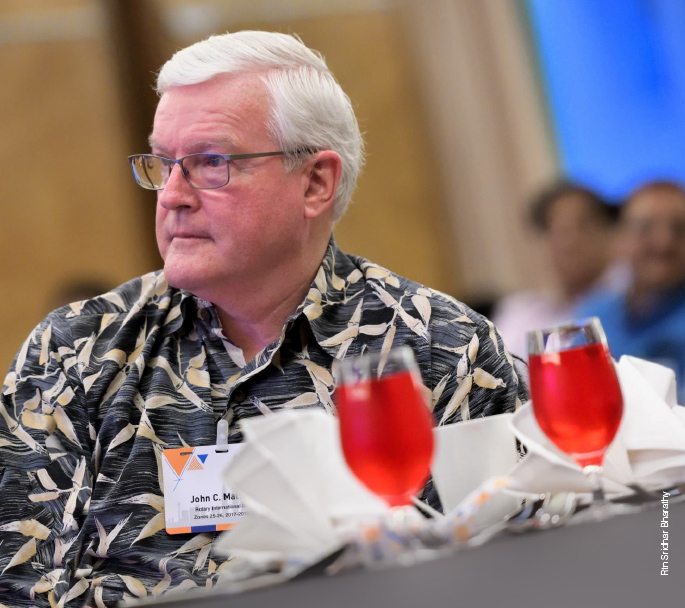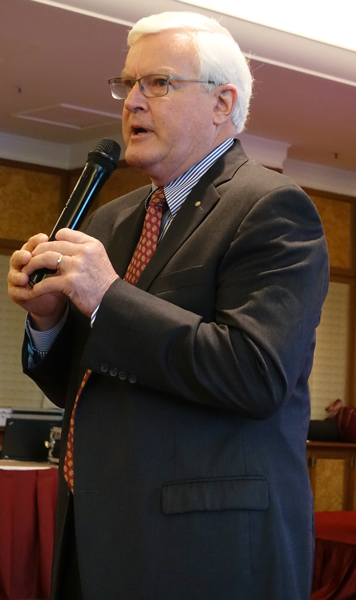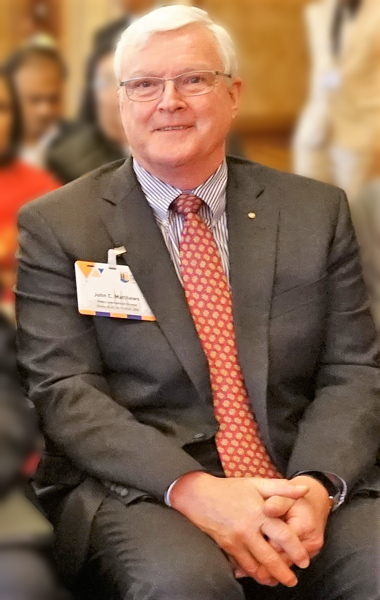He disarms you with his simplicity, easy manner and friendly disposition and the light touch with which he wears the mantle and handles the power of being a Rotary International Director. Add to this his impressive credentials — a Commander of the US Navy which he served for 20 years and a Vice President of the US giant retailer Costco, an expert in HR and risk management and now a senior Rotary leader. John Matthews, from Mercer Island Rotary Club, California, is not only a fun, but a great subject for an interview.

I meet and chat up with Matthews at the Kuala Lumpur Institute and he candidly admits that he is a “late bloomer in Rotary”. And that happened, obviously, because his long years in the US Navy hardly left him enough time to join Rotary, and more important, engage with his club or district’s activities.
Matthews joined the US Navy in 1969; when asked why he says, “I was going to college and at that time in the US, if you were a youth, the idea was that every male citizen would go into military service. I had it in my mind that I would go into service,” just as his father and brother had done before him.
It was wonderful to see the kind of Rotary projects that were going on in Ethiopia. And I thought gosh, this organisation is really powerful and it can do some amazing things.
So after finishing college, he joined the Navy and had a three-year commission, and had no intention of staying on and continuing because he had already been accepted at the graduate school in Columbia, where he was planning to study banking. But as his three-year commission was ending, “I looked around me and thought I really respect the people I work with and I’ve been given a challenge. And then the detailer (the person who helps to move you around) asked me how would you like to go to Sydney in an exchange with the Australian Navy. So I rode my bike home and asked Mary Ellen (his wife) how would you like to go to Sydney and she was fine with it.”
They didn’t have any children then so the decision was easier, and they went to Sydney, “travelled all over and had a wonderful exchange experience.” On his return, this time the detailer asked him if he’d like to go to graduate school. He was game and they decided on a course in financial management. He explains that the US Navy has an arrangement with several universities and he was supposed to do his graduate course in the George Washington University in Washington DC. “But at that time, the Vietnam war was still going on and there was a lot of social unrest on the campus. So the Navy pulled the programme from the campus and said we aren’t sending you there anymore. So I took a left turn and went to the Naval post graduate school.”
One of the biggest challenges was understanding how Rotary works. I thought I had a pretty good idea but I am continually surprised by the stuff I learn every day.
Matthews says his various stints with the US Navy “were always fun and the people were fun too. It wasn’t as though I had planned or intended to go and stay there for so many years! In fact, my mother kept asking when are you going to quit and come home?”
Home was in Rochester, New York State, and it was in New York that he met Mary and “we started dating at 15; so we’ve been together for a while!”
In the Navy, he did several jobs, including that of a Commander at the supply office of the famous USS Kitty Hawk, an aircraft carrier. Later he had a chance to be involved in running the logistics for the Navy from Washington DC.
But while he enjoyed his stint in the US Navy, he also moved 13 times in 20 years and “noticed that my kids weren’t making any close relationships knowing that anyway they would leave within 18 months so why bother.” So he opted for what is known in the naval parlance as a “twilight tour”, which is your last assignment before retirement. This was in San Diego; “I went into the Navy at 22 and came out at 42!”
Enter Rotary!
So how did he become a Rotarian? “Well my dad was a Rotarian, and my uncle a past governor, so I knew about Rotary and that I’d eventually join, but couldn’t do it when in service.”
Matthews clarifies that though the US military rules allow its personnel to join Rotary, the fact remained that “you’re never there. So when I went for the twilight tour in San Diego, I joined the Coronado Club in California. It’s a very good club and I made a lot of friends, but I never really connected to a whole lot of things Rotary did because I would go to work, and then lunch and then work again. I was showing up, but wasn’t really connected,” he says.
A few years later, in 1995, he moved to Seattle with Costco, which he had joined after leaving the Navy and a friend of his said he was going to Ethiopia for an immunisation campaign, “and I decided to go too. I was just telling (Trustee Chair) Paul Netzel here that this was a life-changing experience as it was wonderful to see the kind of Rotary projects that were going on in Ethiopia. And I thought gosh, this organisation is really powerful and it can do some amazing things.”
If we move the idea of sustainability into the membership conversation, we are lousy at it. We don’t do a great job of retaining members. People join and leave and we’ve been at around 1.2 million for 23 years!
This was in 2002, by which time he had joined the Mercer Island Rotary Club and soon after he returned from Ethiopia, “my DG Rosemary called up and said: ‘Hey John, I’ve got this $10,000 grant for new opportunities. Are you interested in putting it to use?’ And I said give it to me.” Even though he had never done a grant till then, he thought he’d “figure it out” and the money went for a hospital project in Addis Ababa, Ethiopia’s capital.
Leadership positions
Next, he became the Foundation Chair for his club, and in 2006–07 the club president, then assistant governor immediately and then the DG in 2010–11. “So as you can see I am a late bloomer in Rotary!”
On the highlights of his as the district governor, Matthews says, “We did a lot of fun things, but the highlight was the relationship I had with my club presidents. They were a wonderful group, and we continued to be connected. And, also a million-dollar dinner!”
Also, as he was then the vice president of Costco, he managed to publish an article on “Polio and what Rotary is doing to move the needle” in the Costco magazine which reaches 70 million people around the world!

Matthews gives an excellent example of the positive energy a really good boss can transmit as he recalls an incident with him. When Matthews assured his boss that he would work really hard — Costco was then on its way to becoming a $100 billion company — and not allow his Rotary responsibilities to get in the way of his day job, “he stopped me, put his hand on my shoulder and said: ‘John, I don’t want you to worry about it. We’ll figure it out. What you are doing for the community is important. And we’ve got to contribute.’ It was a blessing and I’ve never forgotten that.”
He retired from Costco a couple of years ago, after working there for 25 years.
Constantly surprised by Rotary
On the challenges he faces as an RI Director, Matthews says that since he’s travelled globally, “fitting into different cultures and communities around the world wasn’t much of a challenge. But I think one of the biggest challenges was understanding how Rotary works. I thought I had a pretty good idea but I am continually surprised by the stuff I learn every day. As I enjoy learning, it’s a fun job. But it’s also like… are you kidding me… how could I not know that?”
On whether his experience in both the US Navy and Costco has helped his Rotary journey, Matthews says, “Sure, and vice versa. There are also things that Rotary does that I could take into Costco.”
One of these related to the kind of orientation that Rotary clubs in the US do for their new members so that they really engage with Rotary. This was used to retain the members in Costco.
On what kind of leadership qualities are required to take up a Rotarian from a DG to the RI Director’s level, Matthew says, “I believe that Rotary runs on encouragement. Most Rotarians in leadership positions are there because someone said to them you will be good at doing this; go and do it. I had no plans to become a director, and was happy doing work for Rotary till friends came along and planted that idea in my head!”
The last word has to go to the spouse and her/his contribution in a Rotarian’s climb to the pinnacle. So what has been Mary’s role in his success in Rotary, I ask. “I think we make a nice team because she is very approachable and down to earth and everybody, both Rotarians and non-Rotarians, find it easy to come up to her.”
She is a Rotarian too and “do you know her classification? She is a skiing and snow board instructor… one of the better classifications. She has taught skiing for 15 years!”
Pictures by Rasheeda Bhagat
Let’s put sustainability in our membership conversation too
As a member of the RI Board, one of its directors, John Matthews feels that, “though there are a lot of conversations happening right now around things we need to tweak here and there, one of the big challenges we face is that in our 112 years, we’ve added structures but never taken anything away.”
While membership is one of the “easiest things to talk about, I think it’s deeper than that and has to do with sustainability. We operated The Rotary Foundation for 80-odd years but did not have sustainability in our vocabulary! So we did a lot of wonderful projects but many of them failed. When we think of the time, energy, money and other resources that have gone waste because we didn’t build in some idea of sustainability, it sounds crazy. It is crazy that you’ve provided something as wonderful as a clean drinking water facility and it comes apart because something broke and the locals don’t know how to fix it or they are not involved in it. So what TRF is doing right now to build sustainability is absolutely wonderful.”
But the problem, adds Matthews, is that “as happens in most large organisations, what works in one part of the organisation is not transferred to another. So if I take this idea of sustainability and move it into the membership conversation, we are lousy at it. We don’t do a great job of retaining members. People join and leave and we’ve been at around 1.2 million for 23 years. So something is very wrong somewhere. Because you have a core business which is the club and it is not growing. In fact, it is shrinking. We are adding more clubs but in the last 10 years the average size of the club has shrunk by 8, and has come down from 42 to 34.”
Not only are the numbers static in clubs, most clubs are not chartering new clubs. “So we’ve got to change the conversation. In TRF, we set an expectation that every Rotarian will contribute something every year. But there is no such expectation in membership. We just say membership growth is important and we’ve got to grow. But we have to set an expectation that you not only grow, but register growth year-on-year. Because if your business grows and shrinks again, it is not growing. So unless we put ‘sustainability’ in our membership conversation, there is no guarantee we’ll be here 50 years from now.”
Matthews adds that every club should be asked to set up an expectation on membership, and “when we train them in PETS and SETS, we have to look them in the eye and say the expectation is that you will grow this year and the next, and the year after that. And if you can’t grow, then charter a new club.”
He comes out with a shocking statement when he says, “We have thousands of Rotary clubs that have never chartered a new club in years.”







